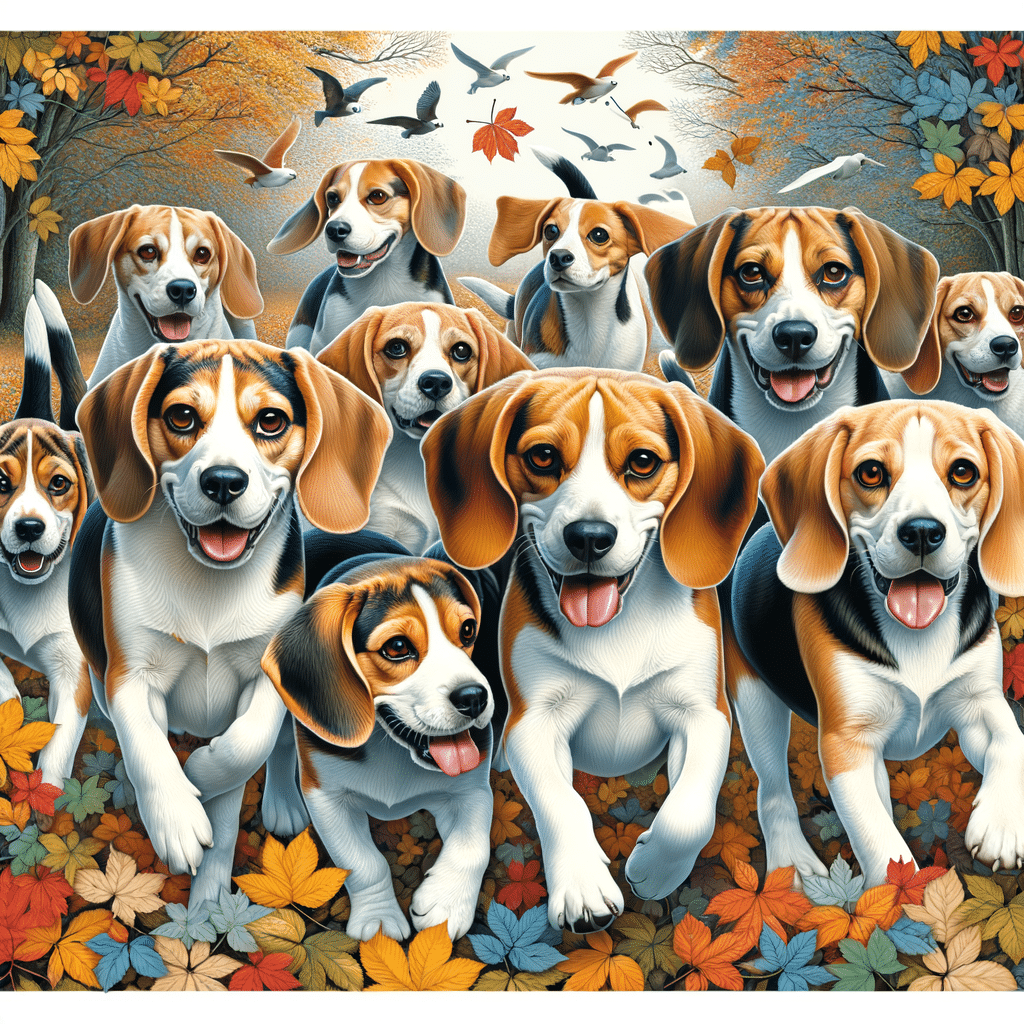Comparing the beagle with the pointer offers insights into two popular canine breeds. Each has its unique heritage and attributes suited for different lifestyles and preferences. A close look at both breeds helps decide between beagles and pointers.
In This Article
Beagles, known for their compact size and friendly demeanor, are nice for first-time dog owners because of their manageable temperament and easy grooming needs. Pointers, dating back to around 1650, have a legacy from the United Kingdom. They have athletic builds and exceptional field abilities, making them a more challenging breed for you if you have never owned a dog before.
Understanding the needs and characteristics of the beagle and the pointer is crucial to ensure a compatible match. Both breeds display a fondness for interaction with children and have low grooming requirements, yet they differ in terms of exercise needs and training approach.
While the beagle may suit your family environment when seeking a less demanding companion in a dog breed, the pointer thrives in active settings. It may work best with an owner who provides ample space and engages in regular, vigorous activities.
Highlights
- According to the American Kennel Club, beagle dogs work well for new dog owners, while pointers are better for experienced owners.
- Both breeds are friendly with children and require minimal grooming.
- Pointers need more exercise and space compared to beagles.
Breed Origins and History
Exploring the dog breeding history of the beagle and pointer breeds reveals distinct but equally storied pasts in England. Understanding their origins provides valuable insight into their present-day characteristics and behaviors.
Origin of beagles
The beagle’s history is deep-rooted in England, with connections dating back to ancient Greece. Initially, small hounds were used for hunting and working. The Romans brought these animals to England. The modern beagle, as recognized today, saw development during the 1300s. Its name likely derives from the French term “beguile,” alluding to the hound’s loud bay. Over time, English beagles were refined, with potential ancestors including the Talbot hound and other English breeds like the Harrier.
Origin of Pointers
Pointers’ lineage dates back to 1650 in the United Kingdom. As gun dogs, they were specifically bred for their ability to locate and point to game birds. The English pointer, as it’s often known, was developed by crossing various breeds, potentially including the Spanish pointer, the greyhound, and traditional foxhounds. The pointer’s role in hunting was finding birds, stopping, and pointing, allowing the hunter to net the game.
Physical Characteristics
When comparing beagles and pointers, their physical characteristics are clearly distinguished, particularly in size, weight, and general appearance. These aspects are crucial in understanding the breed’s suitability for different owners and environments.
Appearance
The beagle typically has a hard, smooth coat that is weather-resistant, and its colors include tricolor, red and white, and lemon. It is a sturdy, compact dog with a characteristic expression often described as pleading. The ears are long and droopy, contributing to its gentle appearance.
In contrast, the pointer, also known as the English pointer, has a short, smooth, and dense coat. The breed’s coat color varies, with liver, lemon, black, and orange either in solid colors or combined with white. Pointers have a distinct, noble head with a long muzzle; their ears are less pendulous than the beagle’s and are set high on the head.
Size and Weight
Beagles are a small to medium breed, with males and females typically standing between 13 to 15 inches at the shoulder. They are solid for their size, with a reasonable expectancy of 20 to 30 pounds. Some still call this animal a pocket beagle, as its small size allows the dog owner to take it almost anywhere.
Pointers are medium to large breed, notably taller and heavier than beagles. They range in height from 23 to 28 inches at the shoulder. Weight varies more significantly with this breed, usually between 45 to 75 pounds. Given their larger size, pointers often require more space to move freely.
Health issues related to physical characteristics, such as hip dysplasia, patellar luxation, and intervertebral disk disease, can occur in both breeds but are particularly important to monitor due to the size and weight differences. Regular veterinary check-ups are recommended to manage and prevent these conditions.
Temperament and Personality
Prospective pet owners should note the distinct characteristics of each breed when considering the temperament and personality of beagles and pointers. Beagles are known for their loving and affectionate nature, while pointers are recognized for their energetic and independent spirit.
Beagle Temperament
The beagle is a breed with a friendly and gentle personality. They are highly affectionate and enjoy the company of children and adults alike, making them ideal family pets. This breed is also known for its playfulness and moderate energy levels, requiring regular exercise to keep them happy. Beagles are intelligent dogs, but they can also be stubborn, which can make training a patient and consistent process.
Characteristics of the beagle:
- Affectionate: Always eager to show love.
- Playful: Loves interactive games.
- Energy Level: Medium, needs daily walks.
- Intelligence: Smart but can be single-minded.
Pointer Temperament
Pointers are athletic and high-energy dogs, often described as being tautly-muscled, true athletes. They are independent, which caters to their strong hunting instincts, yet congenial, making them amenable to being around other animals and people. This breed requires plenty of vigorous exercise and mental stimulation, as they were bred for the purpose of being a hunting dog. Pointers are also intelligent and trainable, responding well to positive reinforcement methods.
Characteristics of the pointer:
- Energetic: Needs a lot of exercise.
- Independent: Self-reliant with a strong hunting drive.
- Playfulness: Enjoys active playtime.
- Intelligence: Learns quickly with the right motivation.
Exploring the temperament and personality of each breed is essential for understanding how they might fit into your life and household.
Care Requirements
As highly popular dog breeds, beagles and pointers have distinct care requirements for their health and well-being. These include regular exercise to prevent obesity, grooming to manage shedding, and attention to health to avoid common breed-specific problems.
Exercise and Training
Beagles
- Exercise: This breed requires daily walks and playtime and is highly prone to obesity without adequate exercise. However, dog sports may be too much for this breed, part of the hound group.
- Training: Beagles are intelligent and have good learning abilities, which makes them ideal family dogs. However, they can also be stubborn, requiring consistent and patient training.
Pointers
- Exercise: High-energy dogs that need more intensive exercises such as running and agility training.
- Training: Known for their high trainability and obedience, they thrive with purposeful activities and consistent training routines.
Grooming and Health
Beagles
- Grooming: Low maintenance; regular brushing suffices due to their short coat.
- Health problems: Beagles are susceptible to issues like hypothyroidism, epilepsy, and spinal problems. Because of some of these problems, you, as an owner, may consider purchasing pet insurance.
Pointers
- Grooming: Also low maintenance; short coats require minimal grooming.
- Health issues: People with hereditary conditions such as progressive retinal atrophy and glaucoma can experience them. Their lifespan generally ranges between 12 and 17 years.
Both breeds may suffer from common canine health issues such as cherry eye, distichiasis, and allergies and thus require regular veterinary checkups to maintain their health.
Frequently Asked Questions
This section addresses common questions regarding the distinct qualities of beagles and pointers, offering insights into their characteristics and suitability as pets.
What are the temperament differences between beagles and pointers?
Beagles have an even temper and gentle disposition, making them excellent companions for children. Pointers are athletic and energetic, requiring more exercise and activities to keep them engaged.
How does the size of a beagle compare to a pointer?
A beagle is generally smaller than a pointer, standing around 13-16 inches at the shoulder and weighing 20-30 pounds. Pointers are taller, ranging from 23-28 inches, and weigh 45-75 pounds.
Which breed ranks higher in intelligence, beagles or pointers?
Pointers have a slight edge in intelligence over beagles, particularly regarding their trainability for hunting and field activities. However, beagles are also intelligent dogs, well-known for their problem-solving abilities.
Are beagles considered to be among the friendliest dog breeds?
Beagles often rank among the friendliest dog breeds, known for their social and welcoming nature. They are generally good with other dogs and people, making them popular family pets.
What is the expected size range for a beagle-pointer mix?
A beagle-pointer mix can have a varied size range, depending on which breed’s traits are more dominant, but one can expect them to stand roughly between 15-28 inches tall and weigh between 30-60 pounds.
Do pointers make good pets for indoor living environments?
Pointers can adapt to indoor living with sufficient space and vigorous exercise. They thrive best with an active lifestyle and ample room to move and play.






